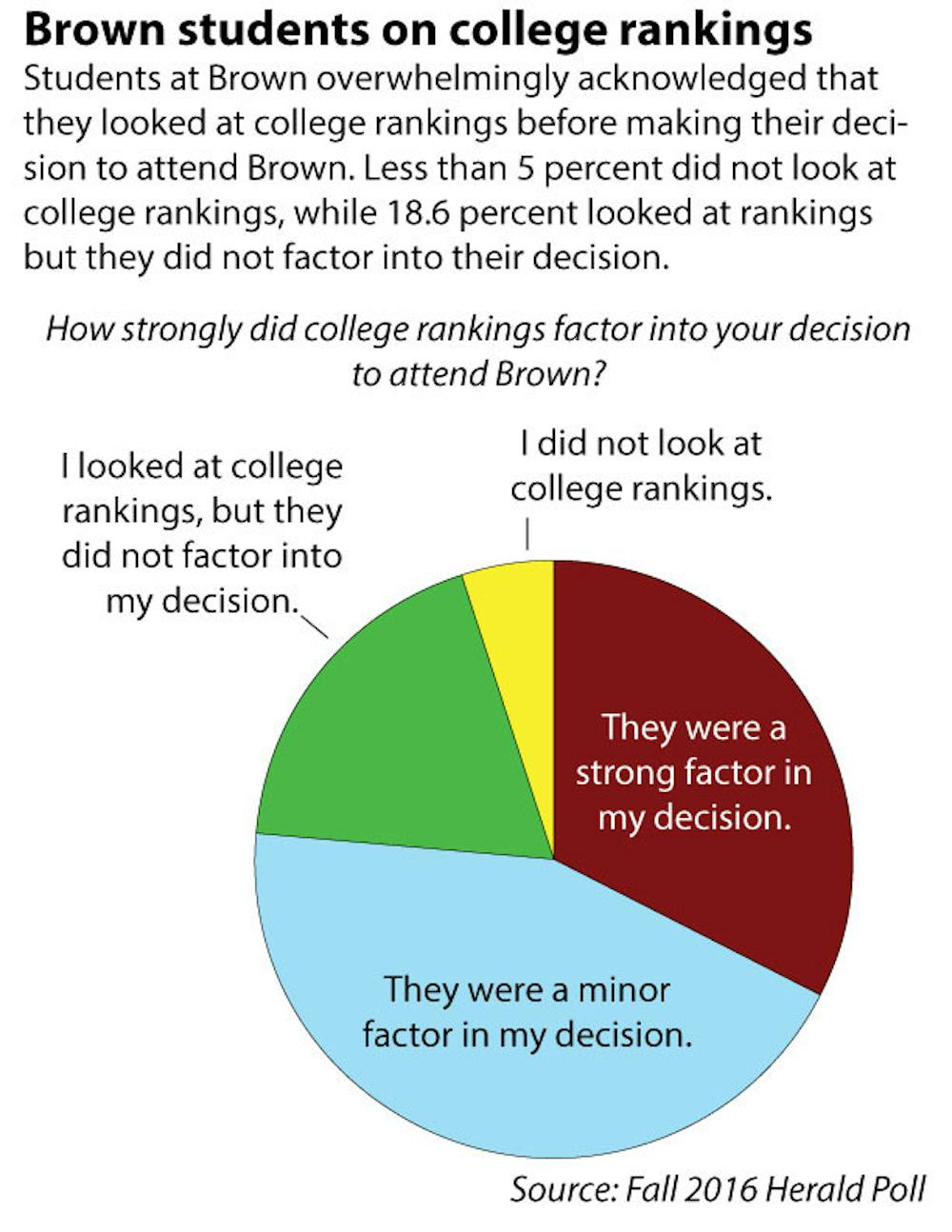Nearly one-third of undergraduates indicated that college rankings were a strong factor in their decision to attend Brown in The Herald’s 2016 fall undergraduate poll. Yet the Admission Office does not coordinate any specific initiatives to boost its rankings in the various lists, said Dean of Admission Logan Powell.
“No part of our process tries to drive up applicant volume” to boost rankings, Powell said. Instead, the office tries “to have the right composition of applicants” by sending publications to prospective students, providing information through an updated website and offering information sessions across the globe. “We strive for a group of applicants who have done their research and understand Brown,” he added.
But other individuals knowledgeable about the college application process do not regard the rankings with such ambivalence. Given that the U.S. News and World Report has produced a ranking of colleges since 1983, according to its website, the lists have enduring cultural relevance.
“It would be a losing battle to try to persuade students to ignore the rankings,” said Brian Taylor, director of Ivy Coach, a college consulting company. College rankings can be a defining factor for students when they decide to apply to and attend a certain school, he said.
Though the lists provide valuable information, they are “all about prestige,” Taylor said. “People love to rank things.”
Brett Levine, director of guidance at Madison High School in New Jersey, said that in his 15 years of counseling, students have always consulted various rankings. “There is a perception that the higher a school is on a list, the higher quality education you will be receiving,” he said.
In some parts of the world, especially Asia, applicants specifically aim to attend schools ranked in the top 10 of the U.S. News and World Report rankings, Taylor said. Foreign applicants are also more disposed to use rankings simply because geographic distance can make visiting campuses difficult, he added.
Cameron McKie ’19, a student from the United Kingdom, said he consulted the Times Higher Education World University Rankings to see how U.S. universities “stacked up” against British schools. International students are forced to go online more to find information about schools, and the rankings are usually on the first page of search results, he added.
But the college brochures and online forums he used to evaluate the fit of the school were more influential in his decision to attend Brown, McKie said. “You have to look around and figure out: If the college were a person, who would they be, and would you get on with them?”
Several college counselors echoed McKie’s moderate approach to applying rankings to the college search process.
“My students don’t really care if a school goes from a four to a five” on the rankings, said Joie Jager-Hyman, founder and president of College Prep 360, a college advising and consulting company. Though Brown is not in the top 10 of the U.S. News and World Report rankings, its ranking “has not hurt it at all. … So many of my students still want to apply,” she said.
Levine said the majority of the students he works with use rankings “in a responsible way” by using the statistics that come with the rankings, such as class size and student-teacher ratio.
Though the Admission Office does not cater its policies to the rankings, “they can be very informative” for the comparison of certain statistics, Powell said. But they should be used in tandem with other resources, he added.
All of the students interviewed for this article emphasized that rankings were not the only factor in their decisions to apply to certain schools.
Andrew Brodsky ’19 glanced at the rankings, but they did not affect his decision to apply to Brown because all of the schools he looked at were ranked similarly, he said.
Hailey Fulkerson ’19 also looked at the rankings, but they were a minor factor in her decision since she decided to apply to Brown before seeing the lists, she said.
Part of the reason many guidance counselors and students are reluctant to put extreme emphasis on rankings may be the incompleteness of the criteria used to rank schools.
“With any set of rankings, you are including some information and excluding some,” Powell said. For example, the U.S. News and World Report rankings do not capture student happiness or advertise specific programs offered by different universities, he added.
Eugyoung Han ’20 chose Brown over other schools she was accepted to because “it had the best science programs,” she said.
Nearly all interviewed students highlighted the flexibility of the open curriculum — a unique offering among Brown’s peer schools — as a major factor in their decision to come here.
Brodsky wanted to concentrate in engineering while exploring other academic departments, he said. “I couldn’t achieve that curriculum somewhere else.”
Other students were drawn to the social life and general atmosphere of the University, which is not quantified by lists such as the one compiled by U.S. News and World Report.
While visiting her cousin on campus, Srishti Lulla ’20 found the atmosphere very relaxed compared to that of other top schools, she said. This environment convinced her to choose Brown over higher-ranked schools, she added.
Ultimately, “there is always an interest … some may say a fascination with rankings,” Powell said. But they should “inform” a student’s search process, not “decide” where a student eventually applies to or attends college.





